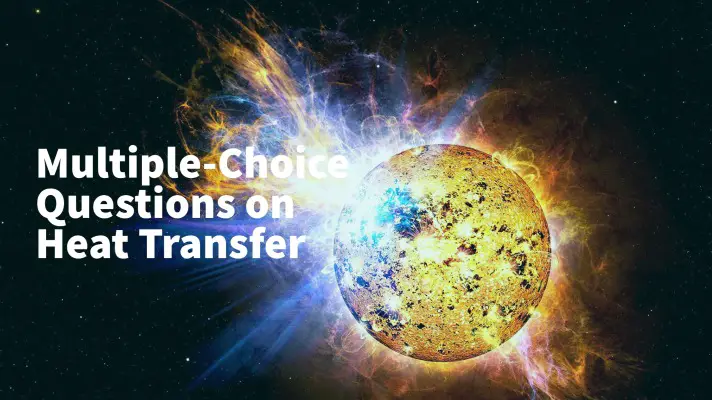Are you making yourself ready for the upcoming examinations? Recently, all the semester examinations and competitive examinations are based on multiple-choice questions. In this article, I will display some Multiple-Choice Questions on Heat Transfer that will boost you in examinations and also in viva.
In the last section, there will be a Quiz on Heat Transfer. Appear for the test and fall in love with studying a lot of objective-type questions.
To download this MCQ sheet, you have to reach the end of this page. There you will find a PDF downloadable button. Click here and download the PDF version of this sheet.
Now, let’s start the objective-type questions or viva questions.

MCQ questions or Viva Questions or Interview Questions on Heat Transfer
- The transmission of energy from one zone to another zone is termed as:
- Conduction
- Convection
- Radiation
- All of these
Ans: (4)
- When the heat energy is transferred from one zone to another zone through their physical contact without the displacement of molecules, it is known as ____.
- Conduction
- Convection
- Radiation
- Advection
Ans: (1)
- When the heat energy is transferred from one zone to another zone through the displacement of molecules, it is known as ____.
- Conduction
- Convection
- Radiation
- Advection
Ans: (2)
- In natural convection, the fluid molecules are displaced due to ____.
- The force applied on the fluid
- The difference in pressure
- The gravity force
- The difference in density
Ans: (4)
- Which mode of heat transfer does not require any medium?
- Conduction
- Convection
- Radiation
- Both (1) and (2)
Ans: (3)
- As per Fourier’s law of conduction, the rate of flow of heat is ____.
- Inversely proportional to the area
- Directly proportional to the square of area
- Directly proportional to the area
- Inversely proportional to the square of area
Ans: (3)
- The heat flow rate is directly proportional to the change of temperature with respect to the length of the heat flow path. This statesman is true as per ____.
- Steffan’s law
- Plank’s law
- Fourier’s law
- None of these
Ans: (3)
- Which one of the following is the unit of the thermal conductivity?
- Newton/m.k
- Watt/m.k
- M.k/watt
- M.k/newton
Ans: (2)
- Which one of the following statesman is true?
- Materials of low thermal conductivities are bad thermal insulators
- Materials of high thermal conductivities are bad thermal insulators
- Materials of low thermal conductivities are good thermal insulators
- Both (2) and (3)
Ans: (4)
- Which of the following category has highest thermal conductivity?
- Metal alloys
- Liquid
- Gas
- Pure metal
Ans: (4)
- Which of the following is the Bridgeman’s assumption for the conductivity of liquids?
- Adjacent molecules are arranged in a circular fashion.
- Adjacent molecules are arranged in a cubical fashion.
- Adjacent molecules are arranged in a hexagonal fashion.
- None of these.
Ans: (2)
- There is a hollow sphere of internal radius r1 and an external radius of r2. The inside and outside temperatures of the sphere are T1 and T2.k is the thermal conductivity. The thermal resistance of the sphere is:
- K(r2-r1)/4*pi*r1*r2
- 4*pi*r1*r2/K(r2-r1)
- (r2-r1)/4*pi*k*r1*r2
- 4*pi*k*r1*r2/(r2-r1)
Ans: (3)
- Which of the following ratio indicates the effectiveness of fin?
- Heat lost without fin/ heat lost with fin
- Heat lost without fin / (heat lost without fin + heat lost with fin)
- Heat lost with fin/ heat lost without fin
- None of these
Ans: (3)
- Which of the following ratio indicates the efficiency of fin?
- Heat lost without fin/ heat lost with fin
- Heat lost from the fin / (heat lost from the fin if the whole surface of the fin is maintained at base temp)
- Heat lost with fin/ heat lost without fin
- Heat lost from the fin if the whole surface of the fin is maintained at base temp/ Heat lost with fin
Ans: (2)
- Which of the following is the unit of heat transfer coefficient?
- w/m.k
- joule/m.k
- w/m^2.k
- joule/m^2.k
Ans: (3)
- When the temperature vary as a function of time in a body, it is called ____.
- Steady heat transfer
- Transient heat transfer
- Lumped heat transfer
- None of these.
Ans: (2)
- In case of lumped body heat transfer, the temperature of the body
- Remains constant throughout the surface
- Changes along with the position
- Does not change with time
- None of these.
Ans: (1)
- Which of the following ratio indicates the Biot number?
- Convective resistance/ conductive resistance
- Conductive resistance/ convective resistance4
- None of these
Ans: (2)
- Heisler charts are applicable for:
- Steady heat transfer
- Unsteady heat transfer
- Transient heat transfer
- Both (2) & (3)
Ans: (4)
- Through which mode, heat is transferred fast?
- Conduction
- Convection
- Radiation
- Both (1) and (2)
Ans: (3)
- Which of the following has lowest thermal conductivity?
- Diamond
- Gold
- Aluminium
- Aerogel
Ans: (4)
- Which of the following ratio indicates the thermal diffusivity?
- Thermal capacity / thermal conductivity
- Viscosity / thermal conductivity
- Thermal conductivity/ thermal capacity
- None of these
Ans: (3)
- The substance that do not transmit any radiation energy is known as ____.
- Black body
- White body
- Opaque body
- Transparent body
Ans: (3)
- In a black body:
- No radiation energy is transmitted.
- Entire incident energy is absorbed.
- Entire incident energy is reflected.
- None of these.
Ans: (2)
- In a white body:
- No radiation energy is transmitted.
- Entire incident energy is absorbed.
- Entire incident energy is reflected.
- None of these.
Ans: (3)
- In case of specular reflection of radiation,
- The angle of reflection = the angle of incidence
- The angle of reflection > the angle of incidence
- The angle of reflection < the angle of incidence
- None of these
Ans: (1)
- Q= σAT4 – this is valid as per ____.
- Stefan Boltzmann law
- Plank’s Law
- Kirchoff’s law
- None of these
Ans: (1)
- The unit of Stefan-Boltzman constant is ____.
- J/m2-sec-K4
- W/ m2-K4
- Both (1) and (2)
- None of these
Ans: (3)
- Which of the following law states that E1/α1= E2/α2; where E1, E2 are emissive powers and α1 and α2 are absorptivities?
- Plank’s law
- Stefan-Boltzmann law
- Kirchoff’s law
- None of these
Ans: (3)
- Which of the following law is the basic law in heat conduction?
- Newton’s law
- Stefan’s law
- Kirchoff’s law
- Fourier’s law
Ans: (4)
Quiz on Heat Transfer
Here is the Quiz on Heat Transfer:
Conclusion
I hope that the Multiple-Choice Questions on Heat Transfer will help you in your college/university examinations and different types of competitive examinations. I will be more encouraged if I get feedback from your end. Please don’t forget to give the feedback by writing in the comment box. Good Luck!


